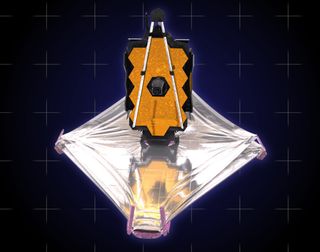NASA delays tightening James Webb Space Telescope sunshield to study power system

NASA personnel are spending the day studying the power subsystem of the massive James Webb Space Telescope to ensure the observatory is ready to execute a key procedure: tensioning its vast sunshield.
The Webb space telescope, which launched on Dec. 25, is conducting a month-long deployment procedure necessary to prepare the telescope to gather data. But most steps in that procedure are controlled from the ground: While NASA has a tentative schedule for the work, mission leaders can decide to adjust the timeline along the way. So after taking Saturday (Jan. 1) as a rest day, the Webb team is spending Sunday (Jan. 2) studying the observatory's power subsystem, NASA announced.
"Nothing we can learn from simulations on the ground is as good as analyzing the observatory when it's up and running," Bill Ochs, Webb project manager at NASA’s Goddard Space Flight Center (GSFC) in Maryland, said in an agency statement released Sunday (Jan. 2). "Now is the time to take the opportunity to learn everything we can about its baseline operations. Then we will take the next steps."
Live updates: NASA's James Webb Space Telescope mission
Related: How the James Webb Space Telescope works in pictures
In particular, the team is focused on the temperature of a set of motors that will be used during sunshield tensioning, the process that separates and smooths the five delicate layers of the kite-shaped sun deflector. (Webb specializes in infrared observations, which are sensitive to heat, making the sunshield a vital component of the observatory.)
"We've spent 20 years on the ground with Webb, designing, developing, and testing," Mike Menzel, Webb's lead systems engineer at GSFC said in the same statement. "We've had a week to see how the observatory actually behaves in space. It's not uncommon to learn certain characteristics of your spacecraft once you're in flight. That's what we're doing right now. So far, the major deployments we've executed have gone about as smoothly as we could have hoped for. But we want to take our time and understand everything we can about the observatory before moving forward."
Tensioning the sunshield is a complex process that NASA expects to take two days. NASA initially intended to start the work on Saturday, but Friday's operations ran later than expected and the team decided to take New Year's Day to rest.
Get the Space.com Newsletter
Breaking space news, the latest updates on rocket launches, skywatching events and more!
And when mission managers decided to take a closer look at the motor temperatures, they didn't want the team to be working on two aspects of the observatory at once.
After the sunshield is fully tensioned, the team will move on to deploying the secondary mirror.
Although deployment has paused, the observatory is still making progress. As of just before 3 p.m. EST (2000 GMT), Webb was more than 510,000 miles (825,000 kilometers) away from Earth, or 57% of the way to its final destination of the Earth-sun Lagrange point 2. That point, also known as L2, is located nearly 1 million miles (1.6 million kilometers) from Earth in the direction opposite the sun.
Email Meghan Bartels at mbartels@space.com or follow her on Twitter @meghanbartels. Follow us on Twitter @Spacedotcom and on Facebook.
Join our Space Forums to keep talking space on the latest missions, night sky and more! And if you have a news tip, correction or comment, let us know at: community@space.com.

Meghan is a senior writer at Space.com and has more than five years' experience as a science journalist based in New York City. She joined Space.com in July 2018, with previous writing published in outlets including Newsweek and Audubon. Meghan earned an MA in science journalism from New York University and a BA in classics from Georgetown University, and in her free time she enjoys reading and visiting museums. Follow her on Twitter at @meghanbartels.
